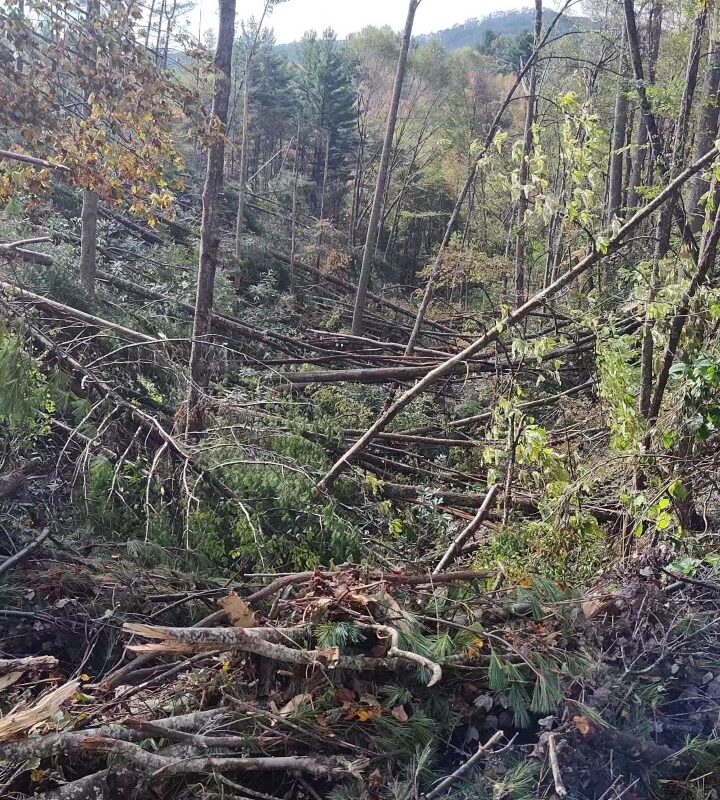Hiking & Helene: Storm Damage Info for 2025 Hikers
November 7, 2024
Hurricane Helene, which hit the southern Appalachians in late September 2024, caused widespread destruction. Now that the initial humanitarian crisis has stabilized, communities are focused on rebuilding efforts. The ATC, A.T. Club volunteers, and agency partners have also begun assessing the Appalachian Trail (A.T.) and the A.T. landscape for damage.
There is still a lot of uncertainty as to what the 2025 hiking season will look like in these hard-hit areas. Hikers will need to be flexible in their plans. Continue reading for the best ways to plan your 2025 A.T. adventure with the information we currently have and learn about how to stay safe in areas with storm damage. We will continue to update our Helene Trail Alert with the latest closures and conditions.
Register your hiking plans on ATCamp.org and sign up to receive urgent Trail Alerts.
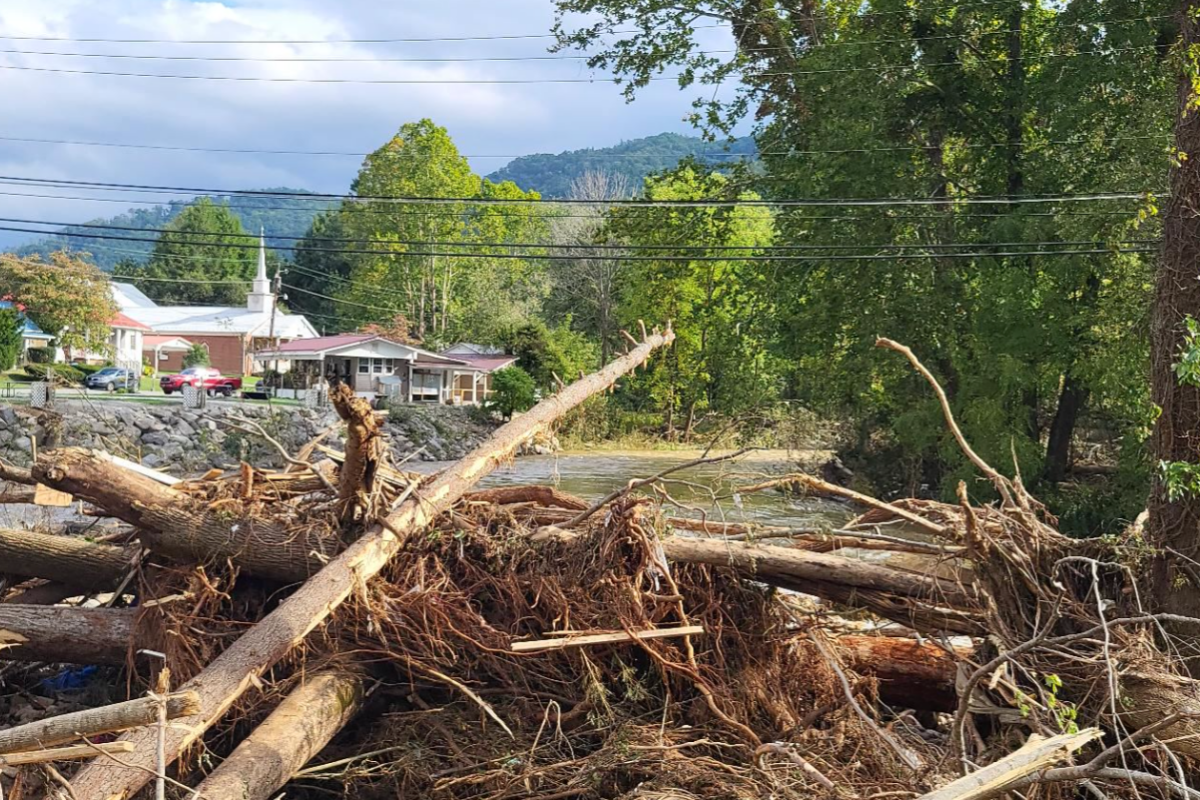
On This Page
Click a link to jump to that section
The Importance of Preparation and Flexibility in 2025

Pack Flexibility, Patience, & Good Judgment
Besides the 10 Essentials, the most important things to pack for your 2025 A.T. hike are flexibility, patience, and good judgment. Conditions will continue to evolve, and you may have to make last-minute changes to your hiking plans.
- Understand that areas with severe storm damage are dynamic. The forest has been completely changed, with some areas losing more than 90% of their tree cover (no more long Green Tunnel in storm damaged areas – so pack extra sunscreen!). Just because a section is open when you start your hike does not mean it will stay open and vice versa.
- Trees will continue to fall as they die and rot,
- Rain could lead to landslides now that these areas no longer have roots holding the soil in place,
- Storm debris unfortunately makes great fuel for wildfires.
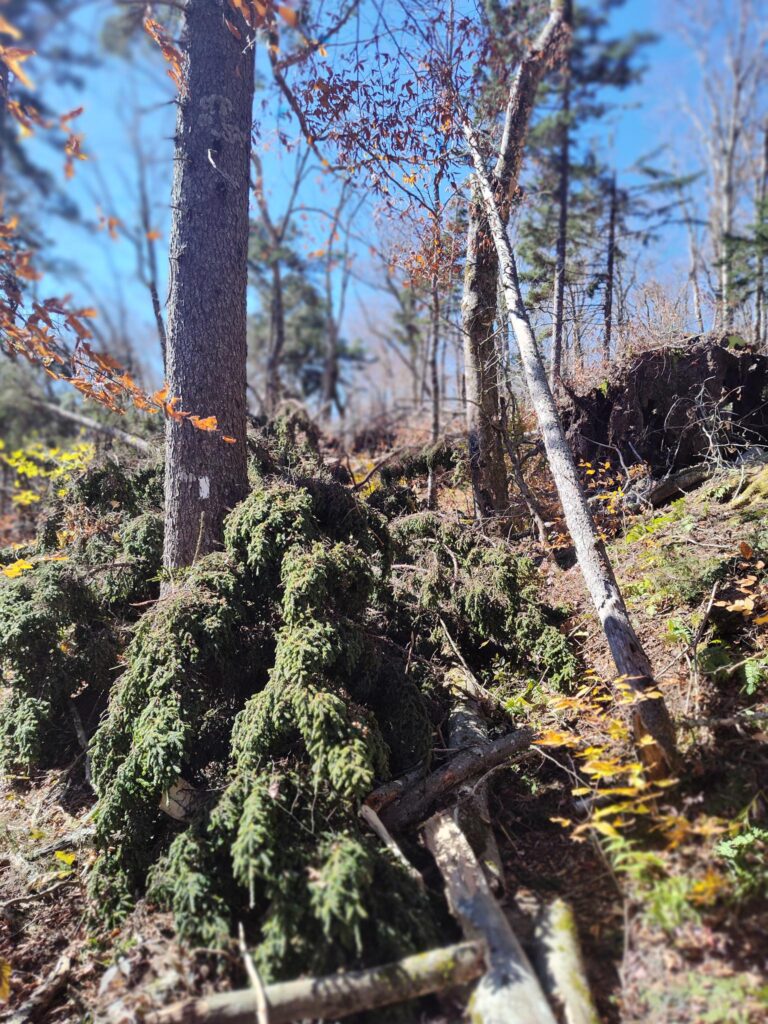
Storm damage in southwest VA. Photo by Jim Baum.
- Remain flexible and be ready to change your plans quickly. We know that many thru-hikers and long-distance hikers have their hearts set on a continuous NOBO (northbound) hike. It is too soon to know when the A.T. will be fully reconnected and where temporary detours will be required.
- It is much easier to mentally prepare for changes before you leave for your hike. Take time while you prepare to think through what it would look like to skip sections, skip north of the worst storm damage, or end your hike early.
- Budget for the possibility of changing plans. Skipping sections and flip-flopping will add transportation, lodging, and other costs. Having emergency funds built into your hike budget will let you be flexible when you need to be.
- Hikers who need to skip sections because of closures or impassable/dangerous conditions are still eligible for the ATC’s 2,000-miler program.
- Exercise good judgment and err on the side of caution. If you come across an open stretch of the A.T. that has severe storm damage and you are unsure if it’s safe to go through, turn around. We know that it is deflating to backtrack or turn around before your destination, but nothing is worth your safety. The Trail will be waiting for you once it is cleared and repaired.
- Please be patient. Again, areas with severe storm damage are dynamic. Conditions will change. Many Trail towns and sections of the A.T. will still bear the scars of the storm. You can show your care for the A.T. and the Trail community by giving others grace as we all rebuild.
- Stay out of closed sections. Sections of the A.T. are rarely closed and only for very good reasons, usually for hiker safety. Staying out of closed sections protects you, protects the Trail from further damage, and protects first responders if there is an emergency.
Consider a Flip Flop Thru-Hike
![]()
Planning a traditional NOBO thru-hike in 2025? Consider flip flopping instead! A Flip Flop hike is when you start somewhere in the middle of the Trail, hike north or south to the end, and then flip back and finish the rest. You can also flip anytime during your hike! If you start NOBO and get to a closed or damaged section, you can flip farther north.
We cannot guarantee that the entire Trail will be open in 2025. However, flip flopping in 2025 and saving southern sections until the last leg of your hike will give volunteers and staff more time to repair the Trail and Trail facilities and establish official detours. This also gives A.T. Communities and hiker services more time to get back up and running.
Flip flop hikes also have other benefits! These include choosing to start your hike in more mild terrain than what is in Georgia and having a longer weather window in which to finish the Trail.
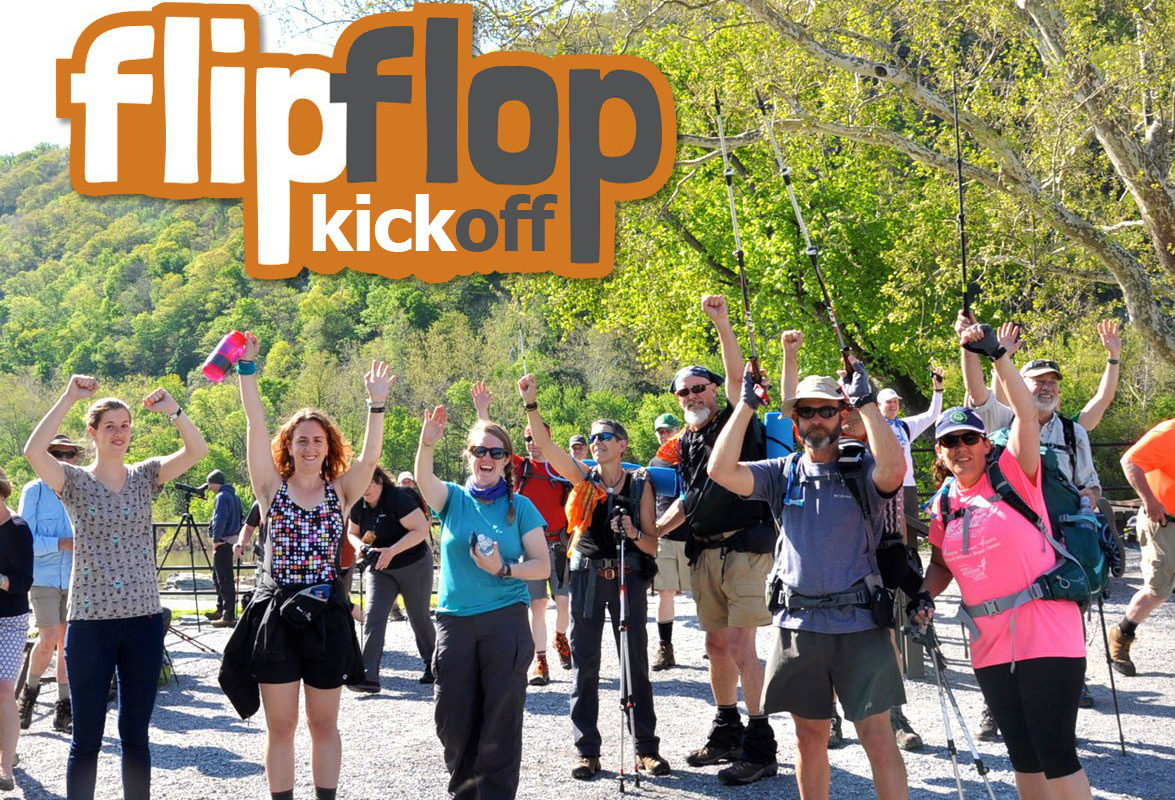
Attend the 2025 Flip Flop Kickoff!
The ATC encourages flip flop thru-hiking to help reduce overcrowding on the A.T. To celebrate these alternative itineraries, we host the Flip Flop Kickoff each April in Harpers Ferry. We hope you’ll join us April 25-27 for the 2025 Kickoff, even if you’re not starting your 2025 Flip Flop in Harpers Ferry!
Storm Damage: What to Expect and How to Stay Safe
The A.T. north of the Smokies into southwest Virginia saw the worst impacts of Helene. Some areas are still closed. Learn about the conditions you may encounter in open sections with severe storm damage and how to stay safe.

Downed Trees
- Also called “blowdowns,” these will range from only a few trees across the Trail to hundreds in a mile or two. They can slow you down to a mile or less an hour and are exhausting to go over, under, and around. Climbing through can be extremely dangerous due to hidden tension points that can cause branches and trunks to snap suddenly. Turn around instead.
- There may be big tangles of blowdowns that completely hide the Trail and cause you to lose the footpath. Bring a map and compass and know how to use them together. Apps like FarOut are not sufficient – apps can have glitches and phones can die. Turn around if you come to a section and cannot easily see the Trail in front of you.
- Know that trees will continue to fall as they die and rot and the ground settles. Trees that have already fallen will continue to settle and move, too. Look for dead or damaged trees (large cracks in the bark, dying or dead branches, major leans).
- And know that downed trees make the perfect fuel for wildfires, which the A.T. is at risk of throughout the hiking season.
Essential Skill:

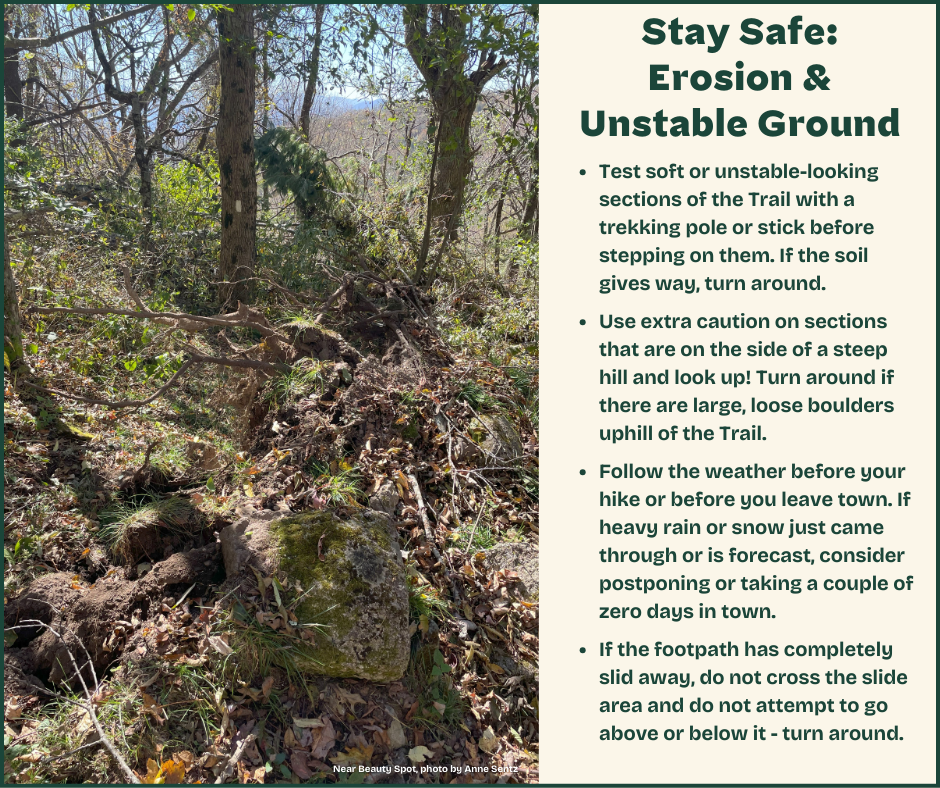
Erosion & Unstable Ground
- Sections of the footpath (also called the tread or treadway) may be washed away. Other sections will be soft and unstable.
- There may be large craters in the treadway due to uprooted trees. These will be especially hard to see in snow.
- Moderate to heavy rain will increase the risk of landslides in areas where lots of trees were blown down since their roots no longer help hold the soil in place.
- Rocks and boulders may slide or fall out of place.
Essential Knowledge:
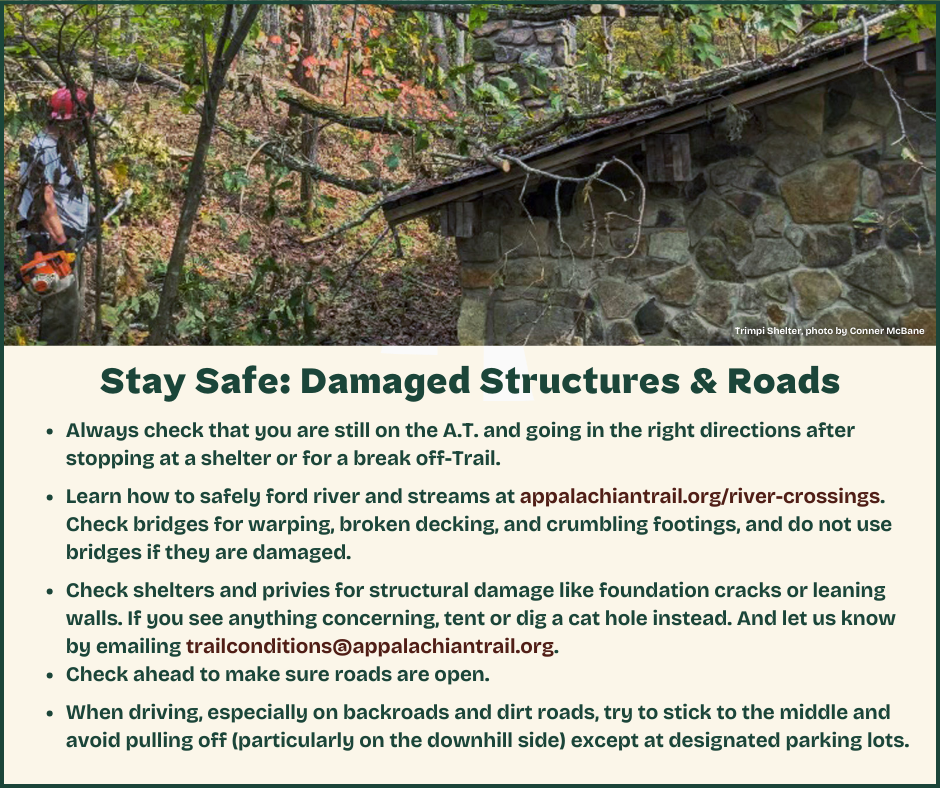
Damaged Structures & Roads
- Shelters and privies may have been damaged, causing them to have structural issues and leaks after trees and debris are cleared.
- Bridges may be damaged, making them unsafe, or may be gone.
- Signs and Trail markers may also be gone.
- Roads may still be closed, and open roads may have soft shoulders or eroded edges.
Essential Skill:

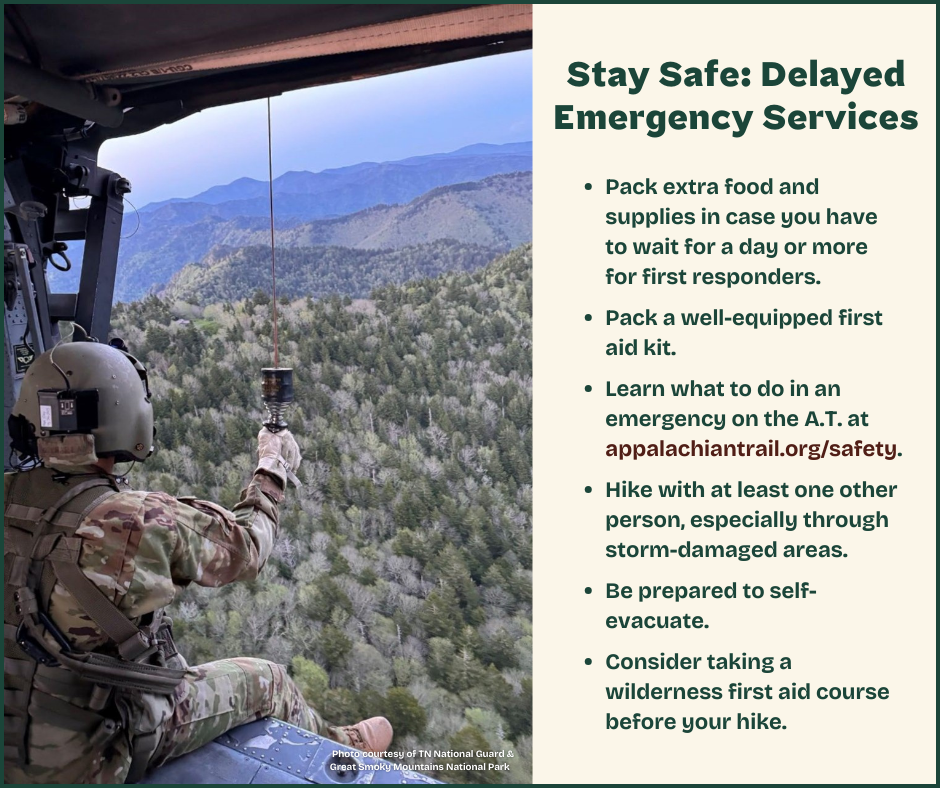
Delayed Emergency Services
The same conditions listed above that make hiking difficult or dangerous may also slow down emergency services. Backcountry search and rescues can already take many hours (rescues in remote areas of the Trail routinely take 10+ hours) and can be even more delayed in areas with storm damage that are hard to get to. Always stay out of closed sections of the A.T. Emergency services may not be available or will likely be delayed even longer in closed sections, and you can put rescuers in danger if they have to come assist you in closed sections.
Essential Knowledge:
Trail Towns and Giving Back
Support Local Businesses
Many small mountain towns along the Trail rely on hiker business during the spring, summer, and fall months. As communities along the A.T. in the south rebuild, you can help recovery efforts by patronizing local businesses!
Be sure to call ahead to make sure services are still available and that towns are welcoming visitors again. If your budget allows:

Helene damage in Damascus, VA. Photo by Drew Hines.
- Buy gear and gear replacements from locally owned outfitters along the way.
- Schedule rides with shuttle providers instead of hitchhiking or yogi-ing a ride at the trailhead (this is also a much safer option!).
- Plan zero days in impacted towns. Hikers tend to spend more money in town the longer they are off Trail, so picking your zero days in places like Hot Springs, Erwin, Roan Mountain and Damascus will help give the local economy a boost.
Give Back
The ATC and our partners are already posting volunteer opportunities to help rebuild the A.T. and will continue to do so into 2025. Sign up for our volunteer newsletter to receive information about opportunities, including our Trail crews.
Receive Volunteer Opportunities
You can also donate to the A.T. Resiliency Fund to give directly to efforts to clear and reconnect the Trail.
If you’d like to help with recovery efforts in towns or at hostels along the way, please call ahead first to ask about opportunities. Help will be welcomed in many places, but showing up unannounced or self-deploying can take up valuable resources, create confusion, or slow things down.
Even though the 2025 hiking season will require more flexibility and patience than other years, remember that we are all stewards of this special place.
The A.T. has flourished for 100 years and, with your help and careful planning, will remain a premier National Scenic Trail for another 100 years and more!

